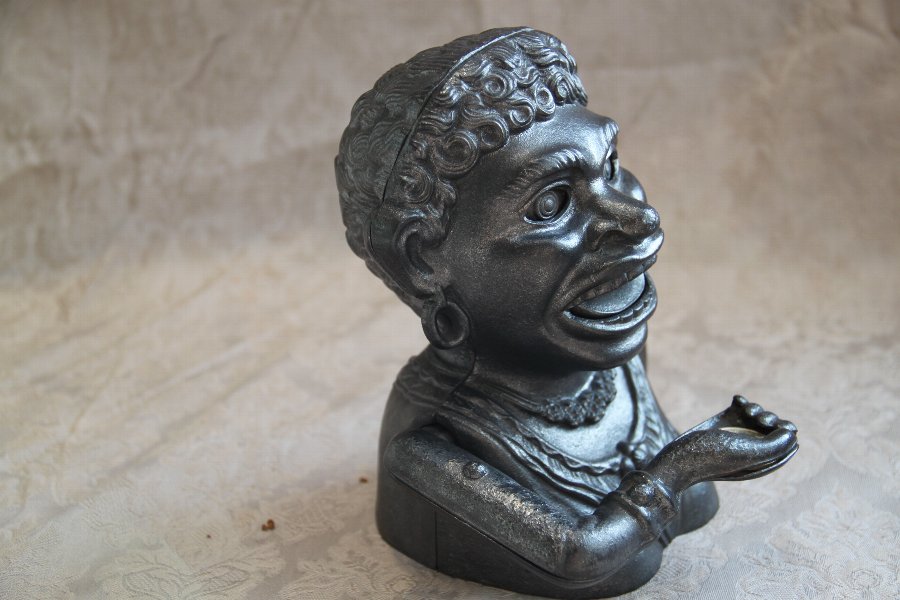

A to Z Photo Dictionary of Japanese Buddhist Statuary. Archived from the original on 14 March 2013. Archived from the original on 28 April 2012. Archived from the original on 11 March 2017. Aberdeen, Washington: Silver Lake Publishing. The Power of Nonverbal Communication: How You Act is More Important Than what You Say. Mike Goutokuji, the stage 1 boss of Touhou Kōryūdō ~ Unconnected Marketeers, is a maneki-neko. Science fiction author Bruce Sterling wrote a short story titled "Maneki Neko," first published in The Magazine of Fantasy & Science Fiction in May 1998. Lucky Cat Lolla, the mascot of the music festival Lollapalooza, is a rendition of a maneki-neko. Ī maneki-neko is also seen in the production logo for Funimation. She won the competition after collecting 529 points at the final.
#CAST IRON MONEY BOX ANTIQUES FULL#
Netta performed her song " Toy" in front of two walls full of maneki-neko at the Eurovision Song Contest 2018. This cat is also prevalent in China domestically, and is usually referred to as simplified Chinese: 招财猫 traditional Chinese: 招財貓 pinyin: zhāocáimāo Jyutping: ziu1 coi4 maau1.Ī Pokémon named Meowth is based on maneki-neko. In popular culture īecause of its popularity in Chinese and Vietnamese communities (including Chinatowns in the United States), the maneki-neko is frequently mistaken for being Chinese in origin rather than Japanese, and is therefore sometimes referred to as a "Chinese lucky cat" or jīnmāo ("golden cat"). Ever after, the "beckoning cat" has been a symbol of good luck for small business owners. In gratitude, the cat sat in the front of the store beckoning customers, thus bringing prosperity as a reward to the charitable proprietor. Brooklyn Museum.Īccording to a folktale, the operator of an impoverished shop (or inn, tavern, temple, etc.) took in a starving stray cat despite barely having enough to feed himself. Ī wooden mold for a maneki-neko and Okiagari-Koboshi Daruma doll from the Edo Period, 18th century. Statues of cats washing their ears (though very different in style to maneki-neko) have been found as early as the Northern Wei Dynasty (386 to 534 AD). In his Miscellaneous Morsels from Youyang, China's Tang Dynasty author Duan Chengshi (803?–863) wrote: "If a cat raises its paw over the ears and washes its face, then patrons will come". Thus, it is possible a belief arose that a figure of a cat washing its face would bring in customers. This belief may in turn be related to an even older Chinese proverb that states that if a cat washes its face, it will rain. There is a Japanese belief that a cat washing its face means a visitor will soon arrive. Some have noted the similarities between the maneki-neko's gesture and that of a cat washing its face. Beyond this the exact origins of maneki-neko are uncertain. A 1902 advertisement for maneki-neko indicates that by the turn of the century they were popular. In 1876, during the Meiji era, it was mentioned in a newspaper article, and there is evidence that kimono-clad maneki-neko were distributed at a shrine in Osaka during this time. Utagawa Hiroshige's ukiyo-e "Joruri-machi Hanka no zu," painted also in 1852, depicts the Marushime-neko, a variation of maneki-neko, being sold at Senso temple, Tokyo.

The earliest records of maneki-neko appear in the Bukō nenpyō's (a chronology of Edo) entry dated 1852. Maneki-neko first appeared during the later part of the Edo period in Japan. It is commonly believed that maneki-neko originated in Tokyo (then named Edo), while some insist it was Kyoto. "Joruri-machi Hanka no zu" by Utagawa Hiroshige, 1852 History

Maneki-neko are sometimes referred to simply as "lucky cats". In addition to statues, maneki-neko can be found in the form of keychains, piggy banks, air fresheners, pots, and numerous other media. Common colors are white, black, red, and gold. Maneki-neko come in different colors and styles and vary in degrees of detail.

Some maneki-neko are equipped with a mechanical paw which slowly moves back and forth. The figurines are often displayed in shops, restaurants, pachinko parlors, dry cleaners, laundromats, bars, casinos, hotels, nightclubs, and other businesses, generally near the entrance. The figurine depicts a cat, traditionally a calico Japanese Bobtail, with a paw raised in a Japanese beckoning gesture. In modern times, they are usually made of ceramic or plastic. 'beckoning cat') is a common Japanese figurine which is often believed to bring good luck to the owner. Maneki-neko with motorized arm beckons customers to buy lottery tickets in Tokyo, Japan


 0 kommentar(er)
0 kommentar(er)
